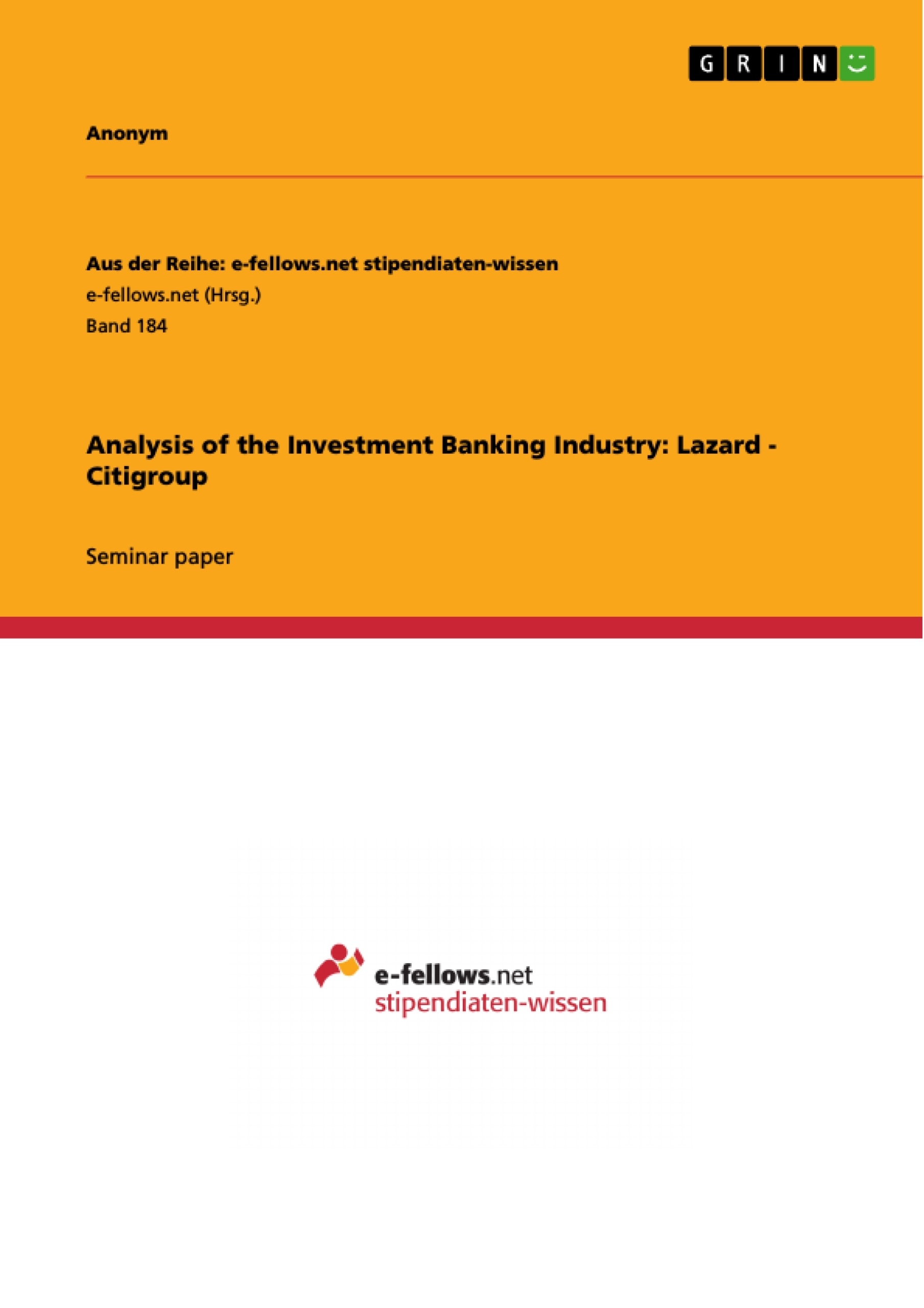This report analyzes the competitive standing of two major players in the investment banking industry: Lazard and Citigroup. Evaluating key criteria in the context of the changing landscape of the industry in addition to regulatory constraints, we see Lazard in a good position for future growth, whereas Citigroup will need significant internal restructuring in order to re-emerge after the near collapse due to the financial crisis.
Table of Contents
- Introduction
- Investment Banks
- Analysis
- Lazard
- Detailed analysis Lazard vs. Citi
- Looking Ahead
Objectives and Key Themes
The objective of this analysis is to examine the investment banking industry, focusing specifically on Citigroup and Lazard in the context of the 2007-2008 financial crisis and its subsequent impact. The analysis explores key trends shaping the future of the industry and assesses the relative positions of Citigroup and Lazard within this evolving landscape.
- Impact of the 2007-2008 Financial Crisis on Investment Banks
- Regulatory Changes and Increased Transparency
- Shifting Global Landscape of Mergers and Acquisitions (M&A)
- Growth of Mid-Market M&A Activity
- Increased Demand for Distressed Debt Advisory and Restructuring Services
Chapter Summaries
Introduction: This introductory section sets the stage for the analysis by highlighting the significant impact of the 2007-2008 financial crisis on the investment banking industry. It emphasizes the increased need for transparency and focus on core business, predicting a rise in the importance of independent investment houses. The introduction also briefly previews six key trends that will influence the future of the industry, serving as a roadmap for the subsequent analysis.
Investment Banks: This chapter delves into the six significant trends impacting the investment banking industry. It examines the far-reaching consequences of increased regulation and transparency following the financial crisis, analyzing how stricter controls on capital and risk management, as exemplified by Dodd-Frank and Basel II, are reshaping the industry. The chapter also discusses the decline in revenues from mergers and acquisitions (M&A) due to economic slowdown and austerity measures, alongside the implications of reduced proprietary trading. Furthermore, the chapter explores the rise of globalization and emerging markets as major drivers of M&A activity, the growth of mid-market M&A, and the increasing demand for distressed debt advisory and bankruptcy restructuring services. The chapter effectively connects these trends to the overall shifting landscape of the investment banking industry, setting the foundation for the comparative analysis of Citigroup and Lazard in later sections.
Analysis: This section presents a detailed comparative analysis of Lazard and Citigroup, leveraging the trends discussed previously. The analysis likely assesses the strengths and weaknesses of each firm in light of the regulatory changes, shifting M&A landscape, and the increased demand for restructuring services. It likely compares their market positions, strategies, and overall performance within the context of the identified industry trends.
Looking Ahead: This concluding section (excluding the final chapter or conclusion, as per instructions) would project the future outlook for the investment banking industry based on the trends discussed earlier and the comparative analysis of Citigroup and Lazard. It would likely offer predictions on the performance and positioning of key players, perhaps suggesting which firms are best positioned to thrive in the new environment.
Keywords
Investment banking, Citigroup, Lazard, financial crisis, regulation, transparency, mergers and acquisitions (M&A), globalization, emerging markets, mid-market, distressed debt, bankruptcy restructuring, proprietary trading, Dodd-Frank Act, Basel II, Basel III.
Frequently Asked Questions: Investment Banking Analysis: Citigroup vs. Lazard
What is the main focus of this analysis?
This analysis examines the investment banking industry, specifically focusing on Citigroup and Lazard in the context of the 2007-2008 financial crisis and its subsequent impact. It explores key trends shaping the future of the industry and assesses the relative positions of Citigroup and Lazard.
What are the key themes explored in this analysis?
Key themes include the impact of the 2007-2008 financial crisis on investment banks, regulatory changes and increased transparency, the shifting global landscape of mergers and acquisitions (M&A), the growth of mid-market M&A activity, and the increased demand for distressed debt advisory and restructuring services.
What is covered in the "Introduction" section?
The introduction sets the stage by highlighting the significant impact of the 2007-2008 financial crisis. It emphasizes the increased need for transparency and focus on core business, predicting a rise in independent investment houses. It previews six key trends influencing the future of the industry.
What significant trends are discussed in the "Investment Banks" chapter?
This chapter details six significant trends: increased regulation and transparency post-financial crisis (including Dodd-Frank and Basel II), the decline in M&A revenues due to economic slowdown, reduced proprietary trading, the rise of globalization and emerging markets, the growth of mid-market M&A, and the increasing demand for distressed debt advisory and restructuring services.
What does the "Analysis" section cover?
The analysis section provides a detailed comparative analysis of Lazard and Citigroup, assessing their strengths and weaknesses in light of the regulatory changes, shifting M&A landscape, and increased demand for restructuring services. It compares their market positions, strategies, and overall performance.
What is the focus of the "Looking Ahead" section?
This section projects the future outlook for the investment banking industry based on the trends discussed and the comparative analysis of Citigroup and Lazard. It offers predictions on the performance and positioning of key players.
What are the key words associated with this analysis?
Investment banking, Citigroup, Lazard, financial crisis, regulation, transparency, mergers and acquisitions (M&A), globalization, emerging markets, mid-market, distressed debt, bankruptcy restructuring, proprietary trading, Dodd-Frank Act, Basel II, Basel III.
What is the overall structure of the document?
The document includes a table of contents, objectives and key themes, chapter summaries, and keywords, providing a comprehensive overview of the investment banking analysis.
What is the intended audience for this document?
This document is intended for academic use, for analyzing themes in a structured and professional manner.
- Quote paper
- Anonym (Author), 2010, Analysis of the Investment Banking Industry: Lazard - Citigroup, Munich, GRIN Verlag, https://www.grin.com/document/176311




